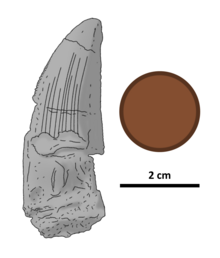
Back Ostafrikasaurus Czech Ostafrikasaurus crassiserratus Spanish اوستافریکاسور Persian Ostafrikasaurus French אוסטפריקזאורוס HE Ostafrikasaurus crassiserratus Italian オスタフリカサウルス Japanese 오스트아프리카사우루스 Korean Ostafrikasaurus Dutch Ostafrikasaurus Polish
| Ostafrikasaurus Temporal range: Late Jurassic, (Tithonian)
| |
|---|---|

| |
| Illustrated holotype tooth, with British penny for scale | |
| Scientific classification | |
| Domain: | Eukaryota |
| Kingdom: | Animalia |
| Phylum: | Chordata |
| Clade: | Dinosauria |
| Clade: | Saurischia |
| Clade: | Theropoda |
| Family: | †Spinosauridae (?) |
| Genus: | †Ostafrikasaurus Buffetaut, 2012 |
| Species: | †O. crassiserratus
|
| Binomial name | |
| †Ostafrikasaurus crassiserratus Buffetaut, 2012
| |
Ostafrikasaurus is a genus of theropod dinosaur from the Late Jurassic period of what is now Lindi Region, Tanzania. It is known only from fossil teeth discovered sometime between 1909 and 1912, during an expedition to the Tendaguru Formation by the Natural History Museum of Berlin. Eight teeth were originally attributed to the dubious dinosaur genus Labrosaurus, and later to Ceratosaurus, both known from the North American Morrison Formation. Subsequent studies attributed two of these teeth to a spinosaurid dinosaur, and in 2012, Ostafrikasaurus crassiserratus was named by French palaeontologist Eric Buffetaut, with one tooth as the holotype, and the other referred to the same species. The generic name comes from the German word for German East Africa, the former name of the colony in which the fossils were found, while the specific name comes from the Latin words for "thick" and "serrated", in reference to the form of the animal's teeth.
Ostafrikasaurus has been tentatively estimated at 8.4 metres (28 feet) long and weighing 1.15 tonnes (1.27 short tons; 1.13 long tons). The holotype tooth is 46 millimetres (1.8 inches) long, has a curved front edge, and is oval-shaped in cross section. The tooth shows serrations that—for spinosaur standards—are unusually large, more so than in any other known taxon. Both the front and back cutting edges are serrated, with two to four denticles per mm (0.04 in). The tooth also has longitudinal ridges on both sides, and the outermost enamel layer has a wrinkled texture in the regions between and without ridges.
Among the oldest known spinosaurid fossils, Ostafrikasaurus may be of importance in understanding the evolutionary origins of spinosaurids and their anatomical adaptations. From comparisons with its later relatives, Ostafrikasaurus indicates that spinosaur teeth became more conical and lost their serrations throughout their evolution. This is possibly a result of becoming more specialized for a piscivorous (fish-eating) diet, as has been suggested for the family based on fossil evidence and the semiaquatic adaptations exhibited by many species. They are also known to have fed on pterosaurs and other dinosaurs. Ostafrikasaurus lived in a subtropical to tropical environment alongside many other dinosaurs, as well as pterosaurs, crocodyliforms, fish, mammals, and invertebrates. Due to its age and location, Ostafrikasaurus indicates spinosaurids may have been globally distributed prior to the breakup of Pangaea.